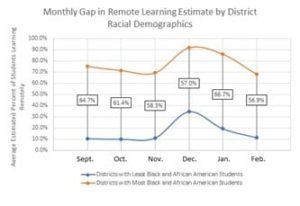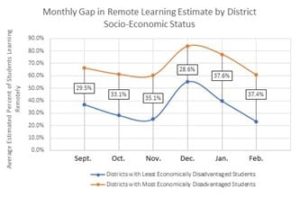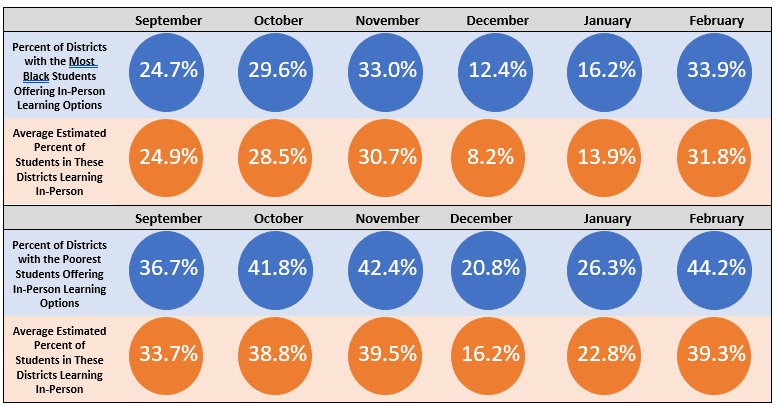Underserved students more likely to be learning remotely, even as more districts provided in-person learning options
Discoveries from Six Months of COVID-19 Extended Learning Data
Data shows that historically underserved students were more likely to be learning remotely, even as more districts provided in-person learning options.
In Brief: A Snapshot of Michigan’s COVID-19 Data
- The six-month average of estimated remote learning rates was nearly five times higher in Michigan districts serving the highest percentages of Black students.
- Students from poorer districts were more likely to be learning remotely. The average estimated rate of students learning remotely was about 34% higher in the poorest districts than in the wealthiest districts for the first six months of the school year.
- The six-month average of estimated remote learning rates was nearly double in the districts with the highest concentrations of low-income students than the wealthiest districts.
Michigan’s Extended COVID-19 Learning data for the first six months of the school year shows that Black students and students from low-income households were consistently more likely to be learning remotely even as more districts provided in-person learning options, a pandemic phenomenon that may exacerbate longstanding inequities in education for historically underserved students, according to a new analysis from the Education Trust-Midwest.
The analysis examined estimated remote learning rates in Michigan districts for the first six months of the current school year — September to February — according to racial and socioeconomic demographics. The data come from Extended COVID-19 Learning Plans, which school districts have been required to submit since August 2020 detailing their educational goals for the year, as well as their offerings on student mode of instruction and the estimated percent of students learning in each mode.
Additionally, the analysis found that as districts across the state began offering more in-person learning opportunities, a majority of districts with high concentrations of underserved students did not. This troubling trend builds upon educational inequities, underscoring a need for more support and extended learning opportunities for underserved students.
On average the estimated rate of students learning remotely was about 61% higher in districts with the highest percentages of Black students between September and February. The six-month average of estimated remote learning rates was nearly five times higher in the districts serving the highest percentages of Black students.[1]
The analysis also found that students from poorer districts were more likely to be learning remotely. The average estimated rate of students learning remotely was about 34% higher in the poorest districts than in the wealthiest districts for the first six months of the school year. The six-month average of estimated remote learning rates was nearly double in the districts with the highest concentrations of low-income students than the wealthiest districts.[2]

Next steps
The data demonstrates that disruptions to learning amid the pandemic have disproportionately impacted students of color, low-income students, students with disabilities and English learners, the same groups of students who have been underserved by Michigan’s education system for generations.
While the Extended COVID-19 Learning Plans and resulting analyses have provided some insight into the racial and socioeconomic disparities impacting Michigan’s historically underserved students, stronger data collection and reporting are needed to better understand the gaps in learning opportunities and ensure that these disparities do not go unaddressed. State leaders should require district learning plan data to be reported disaggregated by race and socioeconomic status, as well as by English learners and students with disabilities, while following federal student privacy guidelines.
Additional data should also be required from districts on attendance and engagement, extended learning opportunities, and socio-emotional supports for students disaggregated by subgroup, including by race and socioeconomic status, especially as they begin to spend recent federal and state investments.
Prioritizing underserved students in all decision-making and investments will be critical to ensure that dollars are being directed to the students who need the most support.
